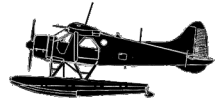
ASN Wikibase Occurrence # 41213
This information is added by users of ASN. Neither ASN nor the Flight Safety Foundation are responsible for the completeness or correctness of this information.
If you feel this information is incomplete or incorrect, you can submit corrected information.
| Date: | Saturday 5 July 1997 |
| Time: | 09:30 LT |
| Type: |  de Havilland Canada DHC-2 Beaver |
| Owner/operator: | Alaska Bush Carriers, Inc. |
| Registration: | N5164G |
| MSN: | 506 |
| Year of manufacture: | 1953 |
| Total airframe hrs: | 13864 hours |
| Engine model: | P&W R-985-AN14-B |
| Fatalities: | Fatalities: 4 / Occupants: 5 |
| Aircraft damage: | Substantial |
| Category: | Accident |
| Location: | near Skwentna, AK -
 United States of America United States of America
|
| Phase: | En route |
| Nature: | Unknown |
| Departure airport: | Lake Hood, AK |
| Chelatna Lake, AK | |
| Investigating agency: | NTSB |
| Confidence Rating: |
The pilot boarded the 4 passengers and cargo (unsecured) for a chartered flight to a fishing lodge. The floatplane departed uneventfully. About 45 min. later, while cruising about 1,700 ft. above rugged terrain and a river, the engine began to lose power and the floatplane descended. The pilot attempted a forced landing in a small lake that was 1,200 ft. in length and located about 1 mile west of the river. During the approach to landing, the airplane stalled and impacted swampy terrain at the lake's edge in a steep nose down attitude. An examination of the wreckage revealed that the no.1 engine exhaust pushrod had failed in fatigue just below the top (valve) ball end. Examination of the pushrod revealed that material had been pushed away from the rod during installation of the ball end. The fatigue crack may have initiated from a score mark produced by the installation. Pushrod life is reduced due to surface scratches. The life of the failed pushrod could not be determined. Insufficient information exists in the overhaul manual regarding pushrod life/inspection.
Probable Cause: a loss of engine power due to the fatigue failure of the no.1 exhaust push rod. Factors contributing to the accident were: insufficient information on pushrod inspection and overhaul from the manufacturer, unsuitable terrain available for landing, and the pilot's failure to maintain airspeed during the approach which led to an inadvertent stall.
Accident investigation:
 |
|
Sources:
NTSB ANC97FA099
Location
Revision history:
| Date/time | Contributor | Updates |
|---|---|---|
| 24-Oct-2008 10:30 | ASN archive | Added |
| 07-Dec-2015 07:22 | JINX | Updated [Time, Operator, Location, Nature, Departure airport, Destination airport, Source] |
| 21-Dec-2016 19:23 | ASN Update Bot | Updated [Time, Damage, Category, Investigating agency] |
| 14-Oct-2017 17:22 | TB | Updated [Location, Damage] |
| 08-Apr-2024 14:25 | ASN Update Bot | Updated [Time, Operator, Other fatalities, Nature, Departure airport, Destination airport, Source, Damage, Narrative, Category, Accident report] |
Corrections or additions? ... Edit this accident description
The Aviation Safety Network is an exclusive service provided by:


 ©2024 Flight Safety Foundation
©2024 Flight Safety Foundation